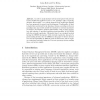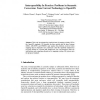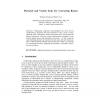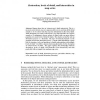COSIT
1997
Springer
14 years 3 months ago
1997
Springer
It is well-known that route distance estimates are influenced by the structure of the route. In particular, the number of features along the route (e.g. landmarks) and the structu...
COSIT
1997
Springer
14 years 3 months ago
1997
Springer
We present an approach to modeling human interpretation of (real) geographic maps. While in Geographic Information Systems (GIS) the limitations for describing geographic knowledge...
COSIT
1997
Springer
14 years 3 months ago
1997
Springer
INTEROP
1999
Springer
14 years 3 months ago
1999
Springer
For data to be successfully integrated, semantically similar database elements must be identified as candidates for merging. However, there may be significant differences between ...
INTEROP
1999
Springer
14 years 3 months ago
1999
Springer
In order to make database systems interoperate with systems beyond traditional application areas a new paradigm called \exporting database functionality" as a radical departur...
INTEROP
1999
Springer
14 years 3 months ago
1999
Springer
Application systems in the earth observation area can be characterised as distributed, platform-inhomogeneous, complex, and cost intensive information systems. In order to manage t...
INTEROP
1999
Springer
14 years 3 months ago
1999
Springer
This work investigates the practical issue of mapping existing GIS to the OpenGIS standards. We describe the data models used in three systems (MGE, ARC/INFO and SPRING) and analys...
COSIT
1999
Springer
14 years 3 months ago
1999
Springer
Traditionally, depictions and descriptions have been seen as complementary; depictions have been preferred to convey iconic or metaphorically iconic information whereas description...
COSIT
1999
Springer
14 years 3 months ago
1999
Springer
COSIT
1999
Springer
14 years 3 months ago
1999
Springer
Landmarks are significant in one’s formation of a cognitive map of both physical environments and electronic information spaces. Landmarks are defined in physical space as having...




